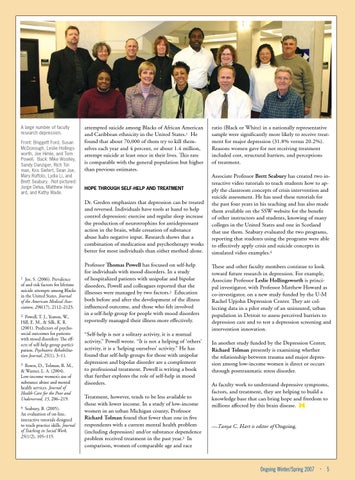A large number of faculty research depression. Front: Briggett Ford, Susan McDonough, Leslie Hollingsworth, Joe Himle, and Tom Powell. Back: Mike Woolley, Sandy Danziger, Rich Tolman, Kris Siefert, Sean Joe, Mary Ruffolo, Lydia Li, and Brett Seabury. Not pictured: Jorge Delva, Matthew Howard, and Kathy Wade.
attempted suicide among Blacks of African American and Caribbean ethnicity in the United States.1 He found that about 70,000 of them try to kill themselves each year and 4 percent, or about 1.4 million, attempt suicide at least once in their lives. This rate is comparable with the general population but higher than previous estimates. Hope through self-help and treatment
Dr. Greden emphasizes that depression can be treated and reversed. Individuals have tools at hand to help control depression: exercise and regular sleep increase the production of neurotrophins for antidepressant action in the brain, while cessation of substance abuse halts negative input. Research shows that a combination of medication and psychotherapy works better for most individuals than either method alone.
1
Joe, S. (2006). Prevalence of and risk factors for lifetime suicide attempts among Blacks in the United States. Journal of the American Medical Association, 296(17), 2112–2123. 2
Powell, T. J., Yeaton, W., Hill, E. M., & Silk, K. R. (2001). Predictors of psychosocial outcomes for patients with mood disorders: The effects of self-help group participation. Psychiatric Rehabilitation Journal, 25(1), 3–11. 3
Rosen, D., Tolman, R. M., & Warner, L. A. (2004). Low-income women’s use of substance abuse and mental health services. Journal of Health Care for the Poor and Underserved, 15, 206–219. 4
Seabury, B. (2005). An evaluation of on-line, interactive tutorials designed to teach practice skills. Journal of Teaching in Social Work, 25(1/2), 105–115.
Professor Thomas Powell has focused on self-help for individuals with mood disorders. In a study of hospitalized patients with unipolar and bipolar disorders, Powell and colleagues reported that the illnesses were managed by two factors.2 Education both before and after the development of the illness influenced outcome, and those who felt involved in a self-help group for people with mood disorders reportedly managed their illness more effectively. “Self-help is not a solitary activity, it is a mutual activity,” Powell wrote. “It is not a helping of ‘others’ activity, it is a ‘helping ourselves’ activity.” He has found that self-help groups for those with unipolar depression and bipolar disorder are a complement to professional treatment. Powell is writing a book that further explores the role of self-help in mood disorders. Treatment, however, tends to be less available to those with lower income. In a study of low-income women in an urban Michigan county, Professor Richard Tolman found that fewer than one in five respondents with a current mental health problem (including depression) and/or substance dependence problem received treatment in the past year.3 In comparison, women of comparable age and race
ratio (Black or White) in a nationally representative sample were significantly more likely to receive treatment for major depression (31.8% versus 20.2%). Reasons women gave for not receiving treatment included cost, structural barriers, and perceptions of treatment. Associate Professor Brett Seabury has created two interactive video tutorials to teach students how to apply the classroom concepts of crisis intervention and suicide assessment. He has used these tutorials for the past four years in his teaching and has also made them available on the SSW website for the benefit of other instructors and students, knowing of many colleges in the United States and one in Scotland that use them. Seabury evaluated the two programs, reporting that students using the programs were able to effectively apply crisis and suicide concepts in simulated video examples.4 These and other faculty members continue to look toward future research in depression. For example, Associate Professor Leslie Hollingsworth is principal investigator, with Professor Matthew Howard as co-investigator, on a new study funded by the U-M Rachel Upjohn Depression Center. They are collecting data in a pilot study of an uninsured, urban population in Detroit to assess perceived barriers to depression care and to test a depression screening and intervention innovation. In another study funded by the Depression Center, Richard Tolman presently is examining whether the relationship between trauma and major depression among low-income women is direct or occurs through posttraumatic stress disorder. As faculty work to understand depressive symptoms, factors, and treatment, they are helping to build a knowledge base that can bring hope and freedom to millions affected by this brain disease. —Tanya C. Hart is editor of Ongoing.
Ongoing Winter/Spring 2007
·
